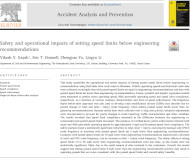12/27/2018
Study: Underposted Speed Limits Diminish SafetyReducing the speed limit below the average speed of traffic can decrease safety according to a study by Penn State researchers.

New research published in the journal Accident Analysis and Prevention suggests that posting speed limits far below engineering recommendations can increase the number of accidents. Pennsylvania State University engineering professors Vikash Gayah and Eric T. Donnell put to the test the "Vision Zero" theory that lowering speed limits automatically improves safety and found results that did not fit with the trends currently in fashion among transportation officials.
The researchers examined eight roads in Montana where state and local officials had deliberately posted speed limit signs that do not reflect the average speed of traffic. The signs imposed limits ranging from 35 MPH to 55 MPH, which were compared to four roads where the limit printed on the sign matched the actual speed of traffic. Long-standing engineering principles recommend that speed limit signs should be based on the speed that 85 percent of traffic chooses to travel in safety during free-flow conditions. In 1964, an exhaustive federal transportation study concluded that traveling below the prevailing speed of traffic is dangerous (view report).
For the latest study, at least two years of crash data were available to test the impact of lowering the speed limit between 5 and 25 MPH for political reasons. Drivers tended to respect limits set within 5 MPH of engineering guidelines but not when it is posted below that amount, the study found.
"Intuitively, this suggests that drivers obey the lower than engineering recommended posted speed limit when it is comparable to the engineering recommended speed limit," the Penn State researchers wrote. "However, when the posted speed limit is much lower than the engineering recommended speed limit (15 MPH or greater), drivers do not choose an operating speed consistent with the posted speed limit."
The study did not examine posting speed limits above the recommended level.
"The operating speed evaluation revealed that drivers tend to more closely comply with the posted speed limit when the posted speed limit is set equal to or just 5 MPH below the engineering recommended value," the researchers observed. "Speed limit compliance lessens and both mean and 85th percentile travel speed increases as the difference between the engineering recommended and posted speed limits increases."
The researchers also found little effect to speeding ticket blitzes run by the state police. Light and medium ticketing efforts had little effect, and average speeds only dropped 4 MPH when police cars were stationed on the side of the road on underposted highways.


